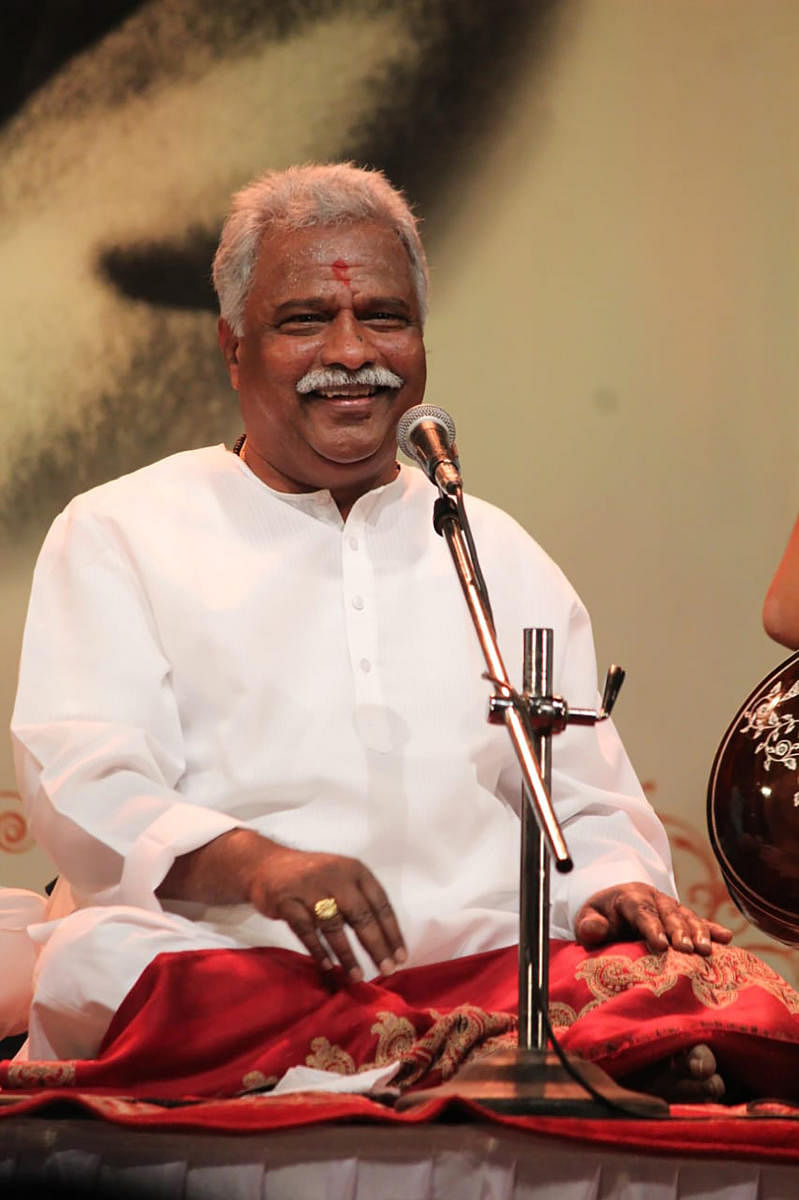
Blessed with a resonant, booming voice, Pandit M Venkatesh Kumar’s signature is his erudite khyals, with equal importance given to devotional Kannada vachanas and dasarapadas. The Hindustani classical vocalist conscientiously mirrors his schooling at the Veereshwara Punyashrama in Gadag where he was trained by the visually-challenged Veerashaiva saint and eminent Hindustani musician Puttaraj Gawai.
Venkatesh Kumar, amongst the most reserved and unassuming musicians, comes across as a picture of poise, courteously taking up questions, with no exchange relegated to being inconsequential in this exclusive interview at New Modern Hotel (NMH) in VV Puram, ahead of his Sree Rama Seva Mandali concert in Chamarajpet.
“I always stay in this hotel. The food, ambience, managing staff and hygiene all align with my discerning shruti. Don’t miss having poori-sagu here,” Venkatesh Kumar’s incredible minimalism begins with this implore. The maestro has recorded multiple devotional and classical CD albums, received a postgraduate degree in music from Gandharva Mahavidyalaya, and served as a professor of music at the University College of Music in Dharwad for 33 years until 2015.
It was young Kumar’s focus and fortitude that catapulted him to receive the Padma Shri in 2016 and several more honours. Isn’t Panditji happy to realise his parents’ dream, and be an inspiration to people who value hard work? “As a young boy yet to enter teens, my family members who found traces of musicality inherent in me, wanted me to concentrate on music. We could not afford a private guru, so in 1966, in the month of Shravana, my maternal uncle, musician Belagallu Veeranna helped us meet Gawai saab which proved to be a turning point. We were given a rebate and asked to deposit Rs 65 for a 12-year Gurukula in music! Hard work was the reality but I had no options. Gradually I realised that one has to be blessed with the right guru to ‘marinate’ in a fitting atmosphere,” laughs Kumar.
Brimming with music
Venkatesh Kumar’s background was rich in fine arts, with his agriculturist father Huleppa being a Janapada singer, open-air theatre artist and leather puppeteer, while his mother Parvathamma a true connoisseur. Young Kumar, one of six siblings, keenly observed his father perform and practice.
“I often sang along with him, even as he taught me verses from Kannada classics,” he says.
Raichur and Ballari districts were brimming with Harikathe, theatre and singing artistes. For the Panditji who hails from Laxmipura in Ballari district (he later made Dharwad his home), the rigorous in-house training at Gawai’s ashram paved the way to national recognition. But the young Kumar had run away from many music classes, unable to come to terms with the strict regulations at the ashram. “But Gawai saab had his own inimitable ways of making the young ones feel at ease. In fact, he could have taught a management lesson or two to today’s youngsters!”
Interpreting melodies
Not just music lessons and prayers, the approaches and methodologies employed by Gawai have stood him in good stead.
“We were led into deep introspection as Gawai explained the melodies, the lyrical connotations, the larger meanings to be interpreted in the sahitya and the ragas,” says Venkatesh Kumar whose rise to stardom was nearly two decades after he left the ashram. Soon after, he was part of national programmes and has been a top artiste of All India Radio since 1988.
Voice culture
And did he receive any special voice culture sessions that reflect his sonorous range? “This is the result of following my guru’s advice to practice. Even the raga-time table we followed was tradition-based. We were told to handle ragas according to time; for example, Todi or Lalath in the morning; Sarang, Bhimpalas or Patdeep for the afternoon, and Maarva, Purya dhanasri or Yaman in the evening, although one had to widen the raga-repertoire as we grew along.”
Only after retiring in 2015 did he concentrate on travelling abroad and accepting full-time concerts. “I have stopped travelling abroad now, it’s only India,” says Kumar known for his seamless blending of key elements in Kirana and Gwalior gharanas. The veteran’s robust style is enriched by characteristics of the Patiala school, especially Bade Ghulam Ali Khan.
“We were taught thumri, tappa, gori, kajri amongst others. Bade Ghulam Ali Khan, Amir Khan, Abdul Karim Khan, D V Paluskar amongst others, each had their own styles. Bade Ghulam Ali Khan would know how to blend ragas into thumris and that made a huge impact on me. I consciously brought this into my stylised presentations, just as my sargam patterns have Carnatic influences,” says the maestro.
Any dreams left to be fulfilled? “Sur is God and I am yet to experience every nuance of the divine. This is a lifelong quest. Students too have to believe in this relentless pursuit,” he signs off demonstrating memorable phrases in Ramdasi Malhar on request.